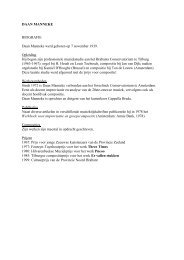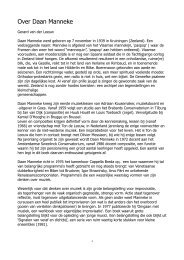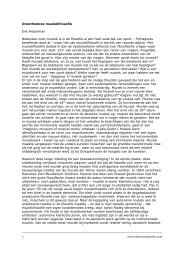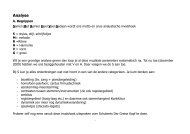Anton Webern and the influence of Heinrich Isaac
Anton Webern and the influence of Heinrich Isaac
Anton Webern and the influence of Heinrich Isaac
You also want an ePaper? Increase the reach of your titles
YUMPU automatically turns print PDFs into web optimized ePapers that Google loves.
temporal relationships between <strong>the</strong> voices remains constant. It is not completely<br />
traditional, in that <strong>the</strong> parts are only rhythmically identical, possessing <strong>the</strong>ir own<br />
unique melodic contours. However, it is in this movement that we see most clearly <strong>the</strong><br />
affinity between <strong>Webern</strong> <strong>and</strong> <strong>Isaac</strong>. Not only is <strong>the</strong>re a palindromic sense to <strong>the</strong> row-<br />
structure <strong>of</strong> <strong>the</strong> movement, beginning with Prime <strong>and</strong> Inversion forms <strong>and</strong> ending<br />
with Retrograde <strong>and</strong> Retrograde inversion forms on <strong>the</strong> same transpositions (see<br />
Example 11). But <strong>the</strong> movement also relates to o<strong>the</strong>r <strong>of</strong> <strong>Webern</strong>’s observations<br />
regarding Choralis Constantinus. In particular his perception that <strong>Isaac</strong> achieves <strong>the</strong><br />
Example 11: Row-structure for Cantata II, movement VI (Whittall, 1999: 219).<br />
Tenor P-8 RI-10 RI-4<br />
Alto I-4 I-10 R-8<br />
Soprano P-0 P-6 RI-8<br />
Bass I-8 R-6 R-0<br />
‘most delicate observation <strong>of</strong> tone-colour in <strong>the</strong> various registers <strong>of</strong> <strong>the</strong> human voice.<br />
This is partly <strong>the</strong> cause <strong>of</strong> <strong>the</strong> frequent radical crossing <strong>of</strong> parts <strong>and</strong> <strong>of</strong> <strong>the</strong>ir movement<br />
by leap’ (<strong>Webern</strong>, 1958: 25) could equally be applied to this movement, besides much<br />
<strong>of</strong> <strong>Webern</strong>’s o<strong>the</strong>r composition. Yet, <strong>Webern</strong> even enhances <strong>the</strong> ‘delicate tone-<br />
colours’ <strong>of</strong> <strong>the</strong> voices with a subtle klangfarbenmelodie unison accompaniment <strong>of</strong><br />
each <strong>of</strong> <strong>the</strong> contrapuntal lines, in <strong>the</strong> orchestra. Once again we see <strong>Webern</strong>, in some<br />
sense, transcending his <strong>influence</strong>.<br />
If, as I argued in <strong>the</strong> introduction, <strong>Webern</strong> was <strong>the</strong> only member <strong>of</strong> <strong>the</strong><br />
‘Second Viennese School’ to go beyond <strong>the</strong> late Romantic aes<strong>the</strong>tic, it seems that this<br />
occurred not through any modernist urge to forge <strong>the</strong> future, but through his looking<br />
back to <strong>the</strong> more distant past <strong>of</strong> <strong>the</strong> Renaissance. However, it was not with nostalgia,<br />
16





![Schubert, Winterreise: Einsamkeit [PDF] - bestmusicteacher.com](https://img.yumpu.com/21166489/1/190x135/schubert-winterreise-einsamkeit-pdf-bestmusicteachercom.jpg?quality=85)

![Schubert, Winterreise: Die Nebensonnen [PDF] - Bestmusicteacher ...](https://img.yumpu.com/20295219/1/190x135/schubert-winterreise-die-nebensonnen-pdf-bestmusicteacher-.jpg?quality=85)
